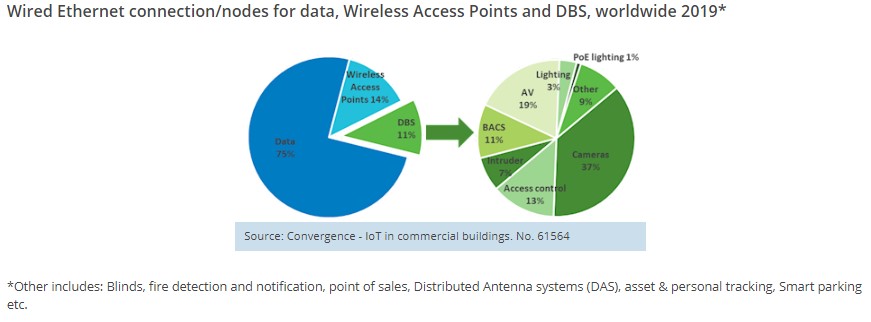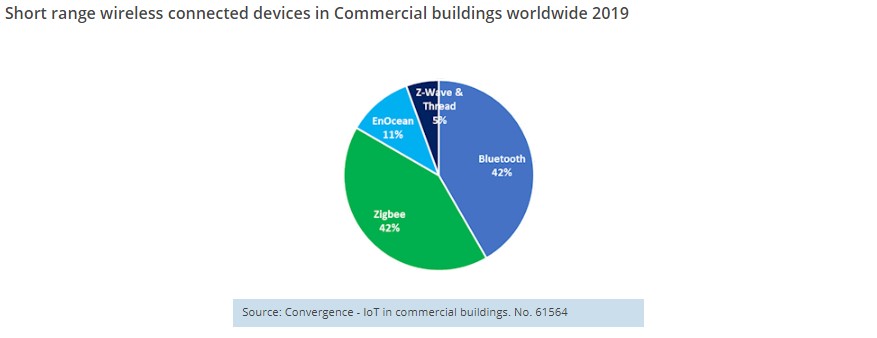Internet of things in commercial buildings
Contents |
[edit] Introduction
While there is a great deal of interest in convergence and in the potential for the Internet of Things (IoT) in commercial buildings, there is still limited understanding of just how many devices are being connected, and many published numbers include consumer devices, residential products, utility metering, asset tracking in the supply chain and industrial product. BSRIA believe there is a need for reliable numbers for connected devices in commercial buildings, as the majority of connected devices in 2020 are audio streaming, data transfer devices (such as fitness trackers and keyboards), home security, automation and utility metering.
[edit] IoT adoption
BSRIA has been tracking convergence in commercial buildings since 2005, and the uptake has been slow, but the organisation expects to see an increase in the number of connected devices from 2025 to 2030 due to the latest developments in both wired and wireless technologies. One example is the Wi-Fi access points (Wi-Fi 6, 802.11ax) which can handle multiple devices using several protocols such as Bluetooth and Zigbee.
A BSRIA study uses the IT/Ethernet network as the basis for estimating the number of connected devices in commercial buildings. Connected devices use an average of 40 - 50 metres of structured cable per device, except for some products that use one connection point for several devices. Daisy chaining where multiple devices are wired together in sequence or in a ring is mainly used for access control products such as lock actuators, readers and keypads and thermostats, sensors and Power over Ethernet (PoE) lights.
There were an estimated 154 million Ethernet connections/ports worldwide in 2019. The majority of these support data (and voice), but a significant number are connected to wireless access points (WAPs) and Distributed Building Services (DBS). The key products included under Distributed Building Services are surveillance cameras, audio/video, access controls and building automation controllers.
An average of 3.6 devices are connected to each of the 17 million Ethernet ports for Distributed Building Services, equivalent to more than 60 million connected (cabled) devices.
[edit] Increase in wireless technology
The use of wireless technologies in commercial buildings is increasing. The most prominent short-range, low-power technologies in commercial buildings are Bluetooth and Zigbee followed by EnOcean.
The typical applications for short range, low power technologies are sensors and lighting. BSRIA estimates the number of connected (wireless) devices in commercial buildings worldwide in 2019 was between 150 - 200 million.
The uptake of low-power wide-area (LPWAN) technologies such as Lorawan, Sigfox and NB-IoT is still very limited in commercial buildings. They are used mainly for smart metering, tracking the supply chain, monitoring of soil and livestock, smart parking and so on.
[edit] Benefits of connectivity
Connectivity is about connecting devices, collecting data and undertaking analytics and diagnostics that will enable end users and building operators to manage and operate their buildings efficiently. The COVID-19 pandemic has increased the focus on safety and trust, which potentially includes monitoring of use and social distancing, access to buildings and increasing use of remote monitoring.
BSRIA expects that the COVID-19 pandemic will negatively impact 2020 sales network infrastructure (structured cabling) and connectable devices due to shut-downs, supply chain interruptions and a reduction in new construction, but in the medium term, the penetration of connected devices could be boosted due to the need for remote monitoring and safety issues.
This article was originally published as 'Uptake of Convergence: IoT in Commercial buildings', on the BSRIA website. It was released in June 2020.
The report, Convergence - IoT in commercial buildings’ can be purchased here.
--BSRIA
[edit] Related articles on Designing Buildings Wiki
- BSRIA articles on Designing Buildings Wiki.
- BSRIA study shows uptake of convergence and IoT in commercial_buildings
- Building Automation and Control System BACS.
- Digital information.
- Digital technology.
- In-building wireless.
- Internet of things IoT.
- Internet of things market.
- Power over ethernet.
- Smart buildings.
- Smart technology.
- The rise of 5G in buildings.
- The smart buildings market.
- WiFi.
Featured articles and news
RTPI leader to become new CIOB Chief Executive Officer
Dr Victoria Hills MRTPI, FICE to take over after Caroline Gumble’s departure.
Social and affordable housing, a long term plan for delivery
The “Delivering a Decade of Renewal for Social and Affordable Housing” strategy sets out future path.
A change to adoptive architecture
Effects of global weather warming on architectural detailing, material choice and human interaction.
The proposed publicly owned and backed subsidiary of Homes England, to facilitate new homes.
How big is the problem and what can we do to mitigate the effects?
Overheating guidance and tools for building designers
A number of cool guides to help with the heat.
The UK's Modern Industrial Strategy: A 10 year plan
Previous consultation criticism, current key elements and general support with some persisting reservations.
Building Safety Regulator reforms
New roles, new staff and a new fast track service pave the way for a single construction regulator.
Architectural Technologist CPDs and Communications
CIAT CPD… and how you can do it!
Cooling centres and cool spaces
Managing extreme heat in cities by directing the public to places for heat stress relief and water sources.
Winter gardens: A brief history and warm variations
Extending the season with glass in different forms and terms.
Restoring Great Yarmouth's Winter Gardens
Transforming one of the least sustainable constructions imaginable.
Construction Skills Mission Board launch sector drive
Newly formed government and industry collaboration set strategy for recruiting an additional 100,000 construction workers a year.
New Architects Code comes into effect in September 2025
ARB Architects Code of Conduct and Practice available with ongoing consultation regarding guidance.
Welsh Skills Body (Medr) launches ambitious plan
The new skills body brings together funding and regulation of tertiary education and research for the devolved nation.
Paul Gandy FCIOB announced as next CIOB President
Former Tilbury Douglas CEO takes helm.
UK Infrastructure: A 10 Year Strategy. In brief with reactions
With the National Infrastructure and Service Transformation Authority (NISTA).


























